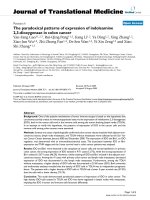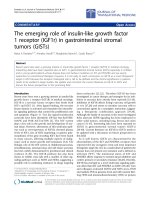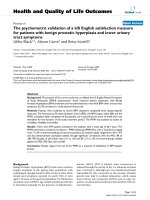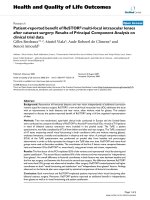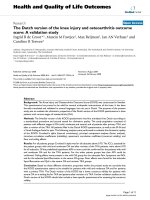báo cáo hóa học:" The long-term benefit of computer-assisted surgical navigation in unicompartmental knee arthroplasty" pptx
Bạn đang xem bản rút gọn của tài liệu. Xem và tải ngay bản đầy đủ của tài liệu tại đây (317.32 KB, 5 trang )
RESEARC H ARTIC LE Open Access
The long-term benefit of computer-assisted
surgical navigation in unicompartmental knee
arthroplasty
Arpad Konyves
1*
, Charles A Willis-Owen
1
, Anthony J Spriggins
2
Abstract
We reviewed the outcomes of 30 consecutive primary unicompartmental knee arthroplasties (UKA) performed by a
single surgeon for medial compartmental osteoarthritis. Fifteen Allegretto knees were implanted without computer
navigation and 15 EIUS knees were implanted with navigation. We compared the survivorship, radiological and
clinical outcomes of the two groups at an average of 8.9 years and 6.9 years respectively. The patients were
assessed clinically using the Oxford Knee Score (OKS) and radiologically using lo ng-leg weightbearing films and
non-weightbearing computed tomography alignment measurements. The overall survivorship was 86.7% at 9 years.
A higher proportion of navigated knees were well aligned with a more reproducible position and malaligned
knees tended to have a less favourable OKS. However, we found no statistically significant difference in survivor-
ship, clinical outcome and radiological alignment between the two groups.
Introduction
Unicompartmental knee arthroplasty (U KA) has proved
to be a popular option in the treatment of isolated med-
ial compartmental osteoarthritis (OA) with good long
term results [1-3]. Isolated medial compartmental OA
has been reported to be present in around 21% in males
and 12% in females [4] or in 85% of knees with clinical
OA [5]. There is little debate that when compared with
total knee arthroplasty (TKA), UKA is less invasive,
causes less morbidity, better reproduces kinematics, and
therefore offers quicke r recovery, better rang e of move-
ment [6] and more physiologic function [7]. However
the use of unicompartmental knee replacement has been
decreasing in recent years [8,9] and this may be due to
the higher overall revision rates compared with TKA in
nat ional joint registries. However, revision rates are still
acceptable considering the theoretical conservative nat-
ure of UKAs and that revision surgery is offered much
more readily when compared with TKAs [10]. On the
other hand, UKAs skilfully implanted into appropriately
selected patients can outperform TKAs over the longer
term [11].
Technically UKAs are less forgiving than TKAs and
certain considerations must be fulfilled; most impor-
tantly overcorrection of the mechanical axis should be
avoided [12]. The advent of minimally invasive implan-
tation, which is now t he preferred approach with advo-
cators of UKAs, has further increased the difficulty in
accurate implantation [13]. Several recent studies have
suggested that the radiological position of implants and
post-operative limb alignment in UKA is superior fol-
lowing the use of computer navigation [14-18]. Clinical
outcome data for computer navigated UKAs is limited,
with one study [19] demonstrating no significant differ-
ences between function parameters of navigated and
non-navigated groups at 2 years. To the best of our
knowl edge, no published studies have examined mid- to
long-term benefits of comp uter navigation in UKA. This
study set out to determine whether more accurate
impl antation using computer navigat ion resulted i n bet-
ter mid- to long term survivorship and clinical
outcomes.
Patients and Methods
Between May 2001 and August 2003, 30 consecutive
primary medial UKAs were performed in 28 patients by
the senior author (AJS). Of these, 15 had a non-
navigated Allegretto (Sulzer, Wintherthur, Switzerland)
* Correspondence:
1
Sports Surgery and Arthroplasty Fellow, SPORTSMED SA, 32 Payneham
Road, Stepney 5069 South Australia
Full list of author information is available at the end of the article
Konyves et al. Journal of Orthopaedic Surgery and Research 2010, 5:94
/>© 2010 Konyves et al; licensee BioMed Central Ltd. This is an Open Access article distributed under the terms of the Creative Commons
Attribution License (http://creativecommons .org/licenses/by/2.0), which permits unrestrict ed use, distribution, and reproduction in
any medium, provided the or iginal work is properly cited .
UKA and 15 had a navigated EIUS (Stryker-Howmedica,
Allendale, NJ) UKA. These knees had been previously
reviewed at a mean of 8 months and 17 months follow-
up for another study [17]. The same patients were once
again assessed clinically and radiologically for the pur-
poses o f this study. We used the same radiological
methods and statistical analyses; clinical results had not
been examined in the previous study.
Radiologic examination consisted of weightbearing
long leg antero-posterior alignment views as well as CT
alignment views as per the Perth protocol. The Perth
protocol [20] uses multiple 3-mm-slice images from the
hip to the talus to produce coronal, sagittal and axial
measure ments. Both sets of images were assessed by the
same radiologist as the previous study, who was blinded
to the treatment method. The zone of the tibial plateau
through which the mechanical axis traversed was ana-
lysed using the methods described b y Kennedy and
White [12] (Figure 1). Patients were sent Oxford Knee
Scores (OKS) questionnaires and any knee symptoms
and range of movement were r ecorded at clinic reviews.
Statistical analysis was perform ed using Fisher exact te st
for 2-group comparison, Kaplan-Meier survivor analysis
to describe survivorship and logrank tests for 2-group
survivorship comparison. Microsoft Excel (Microsoft,
Redmond, Washington) and MedCalc statistical software
(MedCalc Software bvba, Mariakerke, Belgium) were
used for the analysis.
Results
Of the original 30 knees 3 patients had been revised to
total knee replacements, one had been lost to follow-up
(counted as a failure in our survivorship analysis), and two
patients decided not to participate in the study (both were
contacted by phone to ensure that the original UKA was
still in situ - and were therefore counted as successes in
the survivorship analysis). Twenty-two patients (24 knees)
returned the questionnaire and 21 patients ( 23 knees)
attended a radiologic and clinical review. Of the 24 knees
10 had been navigated (9 reviewed) and 14 non-navigated
(14 reviewed). Average age at the time of the operation
was 59 years (range 41-78) in the navigated group and 61
years (range 44-71) in the non-navigated group. There was
no statistical d ifference inagebetweenthetwogroups.
Average follow-up ti me was 6.9 years (range 6.4 to 7.4
years) for the navigated group and 8.9 years (ra nge 7.6 to
10.2 years) for the non-navigated group.
Survivorship
Of the original 28 patients (30 knees), 3 pati ents
(3 k nees) had been revised to total knee replacements;
all 3 were in the navigated group. Two knees had been
revised after one year because of continuing pain and
one knee after 5 years beca use of disease progression.
Cumulative survival after 8 years was 86.7% (Figure 2).
Comparison of survival curv es between the navigated
and non-navigated groups (78.6% vs. 100%) using log-
rank test showed the difference was not statistically sig-
nificant (p = 0.0625).
Radiology
Weightbearing mechanical axis views and CT axis mea-
surements correlated well (r = 0.9 08) with 4 disagree-
ments and 19 agreements. The disagreements were in
the adjacent zones and may represent the effects of
weightbearing.
The mechanical axis crossed the tibial plateau a t a
mean or 42.63% of the tibial width (range 3.33% to
77.50%) with a SD of 19.75%. There was no significant
difference between the means of navigated and non-
navigated knees (42.4% v. 42.8%; p = 0.96). However
there was a higher variance in the non-navigated group,
with a SD 22.5% in the non-navigated group versus
15.1% in the navigated group.
Examining Kennedy zones, 16 knees were well aligned
(in zone 2 and zone C) (table 1). A higher proportion of
navigated knees were well aligned (77% v. 64 %), however
this difference was not significant using a Fisher exact test.
Comparing the Kennedy zones in our previous and
present study, we found that the measurements matched
in 10 knees, differin g in 13 cases. Of the 13 mism atches
the most recent measurements were in adjacent zones
Figure 1 Kennedy’s zones (A-C: mechanical axis). After Kennedy
and White.
Konyves et al. Journal of Orthopaedic Surgery and Research 2010, 5:94
/>Page 2 of 5
in 9 cases. These may have represented an error in mea-
surement or minimal lateral or medial compartmental
deter iorat ion. Four knees showed a measurement differ-
ence of 2 zones, two of these had severe lateral com-
partmental degeneration and two had subsidence of the
tibial components. One of these had been navigated and
one non-navigated.
Clinical outcome
Eighteen out of 24 knees had c ontinued to do well with
good to excellent scores on the OKS. The median OKS
was 40 (12 worst, 48 best) with a mean of 37.7 (SD 9).
There was no significant difference in scores between
the navigated and un-navigated groups (Figure 3).
Although a larger proportion of m alaligned knees had
a poor to fair OKS than w ell aligned knees (28% v.
13%), we found no statistically significant difference
using the Fisher exact test. This may have been due to
the small number of patients in our study.
All but two knees had a range of flexion beyond 100
degrees; we did not find a correlation between range of
movement and alignment of the leg. There was one
patient i n each group with a range of flexion less than
100 degrees, one of whom (non-navigated) reported
excellent results (OKS 45) and one (navigated) who
reported poor results ( OKS 18). Pre-operative
movement was not recorded in every case and therefore
we did not attempt to make comparisons.
Discussion
Unicompartmental knee arthroplasty (UKA) is an attrac-
tive option for isolated medial compartmental osteoar-
thritis with good long-term results [1-3]. A substantial
proportion of patients undergoing knee arthroplasty are
suitable for UKA, which would result in a functionally
superior outcome with function similar to the native
knee at a reduced cost to the health service [21]. How-
ever the use of UKA has be en declining [9] in recent
years and this may be due to technically challenging sur-
gery and difficulties in the accurate placement of the
implants, which is key to a successful clinical outcome.
Computer-assisted surgical navigation has the poten-
tial to improve the accuracy of implant positioning,
however its effect on clinical outcome is still debatable.
The relatively r ecent introduction o f computer naviga-
tion means that long-term studies are not available yet.
However, short- to mid-term studies in TKAs [22,23]
and a short-term study in UKA [19] found no statistical
difference between navigated and non-navigated knees.
This study did not de monstrate a significant difference
in the longer term survivorship and clinical outcomes of
navigated and n on-navigated UKAs. A larger proportion
of well aligned knees had good or excellent clinical out-
comes and a higher propo rtion o f na vigated knees w ere
well aligned, though these trends were not statistically sig-
nificant. The importance of accurate mechanical align-
ment in TKAs has been debated recently [24] and our
poorer (although statistically not significant) survivorship
results show that more accurate and reproducible implant
positioning may not necessarily lead to a better survival.
Our p revious study [17] showed that computer navi-
gation facilitated a higher rate of knees to be in the
desired zone for leg alignment. In the present study
there is a tendency, but the difference is statistically not
Figure 2 Kaplan-Meier survival curve of the whole cohort
(navigated and non-navigated knees) showing 86.7% survival
at 8 years with 95% confidence interval (CI) and the number of
knees at risk at the beginning of each year.
Table 1 Number of patients in Kennedy zones on
alignment views.
Navigated Non-navigated Total
Zone 1 1 2 3
Zone 2 2 3 5
Zone C 5 6 11
Zone 3 1 3 4
Zone 4 0 0 0
Figure 3 Graph showing OKS of mean 35.5 (95% CI 28.4 to
42.6) for navigated knees and mean 39.4 (95% CI 35.8 to 42.9)
for non-navigated knees (p = 0.35).
Konyves et al. Journal of Orthopaedic Surgery and Research 2010, 5:94
/>Page 3 of 5
significant using the same statistical tests. We demon-
strated minor changes in leg alignment over time in 9
knees and substantial changes in 4 knees. It is not clear
how much these minor changes represent an actual
deterioration and how much they represent an intra-
observer error, as only measurements were available
from the previous study.
The limitations of our study lie mainly in the small sam-
ple size and thus a loss of statistical power. The differences
in survival between the two groups was statistically not sig-
nificant (p = 0.06 25), however with longer follow-up this
may become significant in favour of the non-navigated
group. The implants used in the two groups were different,
however both were fully cemented, fixed bearing unicom-
partmental knees with a similar design rati onale. We had
good results with the Allegretto, but a change to the EIUS
was necessary to enable us to use the navigation system in
our hospital. The cohort in our study also represents the
initial part of the senior surgeon’s learning curve with com-
puter n avigation, which may have affected our results unfa-
vourably [25] . At the time of the cha nge the EIUS wa s
relativ ely new without long-term registry data. The latest
National Joint Registry [9] reports higher revision rates for
the EIUS (3.3 vs. 1.8 revisions per 100 obs. years) which
may be a factor in our survival analysis. Since our navigated
cohort followed on our non-navigated group, ranges of fol-
low-up do not overlap. Therefore outcome measures are
obtained on average 2 years apart and any difference in the
groups may be attributed to a natural disease progression.
Although there is evidence that increased operating
times can result in higher infection rates [26], it is our
impression that the time spent on setting up t he com-
puter referencing does not significantly add to the over-
all operating time and may even be offset by the time
taken to place jigs and perform bone resections.
Conclusion
This study demonstrates that there is no difference in
survivorship and radiological alignment or OKS between
navigated and non-navigat ed UKAs at an a verage of 6.9
years and 8.9 years, respectively. Long-term follow-up
with larger patient groups will be required to establish
whether component alignment is a predictor for a suc-
cessful clinical outcome and to justify the routine use of
computer navigation in UKAs.
Author details
1
Sports Surgery and Arthroplasty Fellow, SPORTSMED SA, 32 Payneham
Road, Stepney 5069 South Australia.
2
Consultant Orthopaedic Surgeon,
SPORTSMED SA, 32 Payneham Road, Stepney 5069 South Australia.
Authors’ contributions
AK collected and analysed data and drafted the manuscript; CWO
contributed to statistical analysis and revisions of the manuscript; AJS
conceived of the study. All authors read and approved the final manuscript.
Competing interests
The authors declare that they have no competing interests.
Received: 19 July 2010 Accepted: 31 December 2010
Published: 31 December 2010
References
1. Svärd UCG, Price AJ: Oxford medial unicompartmental knee arthroplasty: a
survival analysis of an independent series. J Bone Joint Surg [Br] 2001, 83-B:191-4.
2. Barck AL: 10-year evaluation of compartmental knee arthroplasty. J
Arthroplasty 1989, 4(Suppl):S49-54.
3. Heck DA, Marmor L, Gibson A, et al: Unicompartmental knee arthroplasty:
A multicenter investigation with long-term follow-up evaluation. Clin
Orthop 1993, 286:154-159.
4. McAlindon TE, S S, Cooper CS, Dieppe PA: “Radiographic patterns of
osteoarthritis of the knee joint in the community: The importance of the
patellofemoral joint.”. Annals of the Rheumatic Diseases 1992, 51(7):844-849.
5. Ahlbäck S: “Osteoarthrosis of the knee: a radiographic investigation.”.
Acta Radiol[Diagn](Stockh) 1968, Suppl 277:7-72.
6. Amin AK, Patton JT, Cook RE, Gaston M, Brenkel IJ: Unicompartmental or
total knee arthroplasty?: results from a matched study. Clin Orthop Relat
Res 2006, 451:101-6.
7. Laurencin CT, Zelicof SB, Scott RD, Ewald FC: Unicompartmental versus
total knee arthroplasty in the same patient. A comparative study. Clin
Orthop Relat Res 1991(273):151-6.
8. No listed authors: National Joint Registry for England and Wales. 2009
[].
9. No listed authors: Australian Orthopaedic Association national Joint
Replacement Registry. Annual Report Adelaide: AOA; 2009.
10. Deshmukh RV, Scott RD: Unicompartmental knee arthroplasty: long-term
results. Clin Orthop 2001, 392:272-8.
11. Newman J, Pydisetty RV, Ackroyd C: Unicompartmental or total knee
replacement: the 15-year results of a prospective randomised controlled
trial. J Bone Joint Surg Br 2009, 91(1):52-7.
12. Kennedy WR, White RP: Unicompartmental Arthroplasty of the Knee:
Postoperative Alignment and its Influence on Overall Results. Clinical
Orthopaedics 1987, 221:278-285.
13. Fisher DA, Watts M, Davis KE: Implant position in knee surgery: a
comparison of minimally invasive, open unicompartmental and total
knee arthroplasty. J Arthroplasty 2003, 18(Suppl 7):2-8.
14. Jung KA, Kim SJ, Lee SC, Hwang SH, Ahn NK: Accuracy of implantation
during computer-assisted minimally invasive Oxford unicompartmental
knee arthroplasty. A comparison with a conventional instrumented
technique. Knee 2009, 17(6):387-91.
15. Rosenberger RE, Fink C, Quirbach S, Attal R, Tecklenburg K, Hoser C: The
immediate effect of navigation on implant accuracy in primary mini-
invasive unicompartmental knee arthroplasty. Knee Surg Sports Traumatol
Arthrosc 2008, 16(12):1133-40.
16. Keene G, Simpson D, Kalairajah Y: Limb alignment in computer-assisted
minimally-invasive unicompartmental knee replacement. J Bone Joint
Surg Br 2006, , 88-B: 44-48.
17. Cossey AJ, Spriggins AJ: The use of computer-assisted surgical navigation
to prevent malalignment in unicompartmental knee arthroplasty. J
Arthroplasty 2005, 20(1):29-34.
18. Jenny JY, Boeri C: Unicompartmental knee prosthesis implantation with a
non-image-based navigation system: rationale, technique, case-control
comparative study with a conventional instrumented implantation. Knee
Surg Sports Traumatol Arthrosc 2003, 11:40.
19. Seon JK, Song EK, Park SJ, Yoon TR, Lee KB, Jung ST: Comparison of
minimally invasive unicompartmental knee arthroplasty with or without
a navigation system. J Arthroplasty 2009, 24(3):351-7.
20. Chauhan SK, Clark GW, Lloyd S, Scott RG, Breidahl W, Sikorski JM:
Computer-assisted total knee replacement. A controlled cadaver study
using a multi-parameter quantitative CT assessment of alignment (the
Perth CT Protocol). J Bone Joint Surg Br 2004, 86(6):818-23.
21. Willis-Owen CA, Brust K, Alsop H, Miraldo M, Cobb JP: Unicondylar knee
arthroplasty in the UK National Health Service: an analysis of candidacy,
outcome and cost efficacy. Knee 2009, 16(6):473-8.
22. Spencer JM, Chauhan SK, Sloan K, Taylor A, Beaver RJ: Computer
navigation versus conventional total knee replacement: no difference in
functional results at two years. J Bone Joint Surg Br 2007, 89(4):477-480.
Konyves et al. Journal of Orthopaedic Surgery and Research 2010, 5:94
/>Page 4 of 5
23. Kamat YD, Aurakzai KM, Adhikari AR, Matthews D, Kalairajah Y, Field RE:
Does computer navigation in total knee arthroplasty improve patient
outcome at midterm follow-up? Int Orthop 2009, 33(6):1567-70.
24. Parratte S, Pagnano MW, Trousdale RT, Berry DJ: Effect of Postoperative
Mechanical Axis Alignment on the Fifteen-Year Survival of Modern,
Cemented Total Knee Replacements. J Bone Joint Surg Am 2010,
92:2143-2149.
25. Stulberg SD, Loan P, Sarin V: Computer-Assisted Navigation in Total Knee
Replacement: Results of an Initial Experience in Thirty-five Patients. J
Bone Joint Surg Am 2002, 84:90-98.
26. Willis-Owen CA, Konyves A, Martin DK: Factors affecting the incidence of
infection in hip and knee replacement: an analysis of 5277 cases. J Bone
Joint Surg Br 2010, 92-B:1128-1133.
doi:10.1186/1749-799X-5-94
Cite this article as: Konyves et al.: The long-term benefit of computer-
assisted surgical navigation in unicompartmental knee arthroplasty.
Journal of Orthopaedic Surgery and Research 2010 5:94.
Submit your next manuscript to BioMed Central
and take full advantage of:
• Convenient online submission
• Thorough peer review
• No space constraints or color figure charges
• Immediate publication on acceptance
• Inclusion in PubMed, CAS, Scopus and Google Scholar
• Research which is freely available for redistribution
Submit your manuscript at
www.biomedcentral.com/submit
Konyves et al. Journal of Orthopaedic Surgery and Research 2010, 5:94
/>Page 5 of 5

